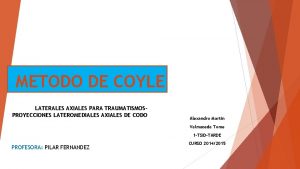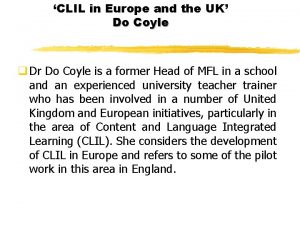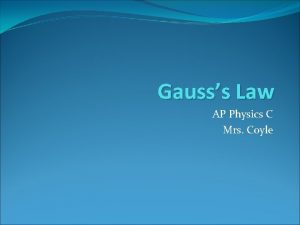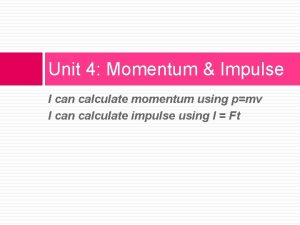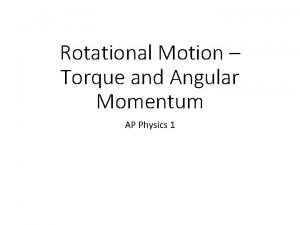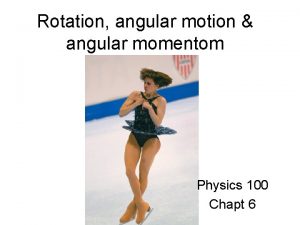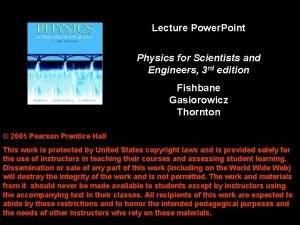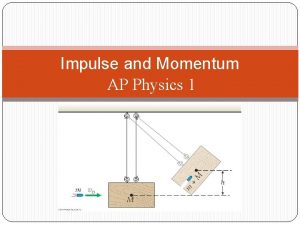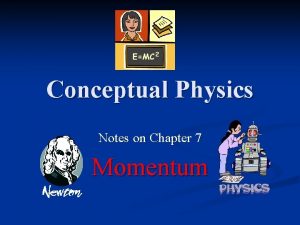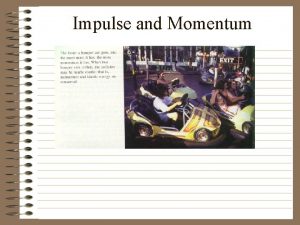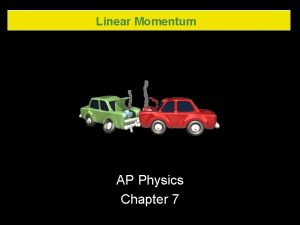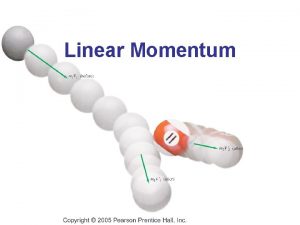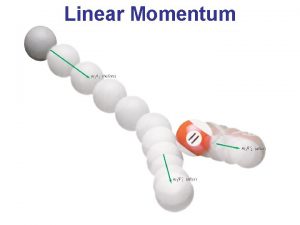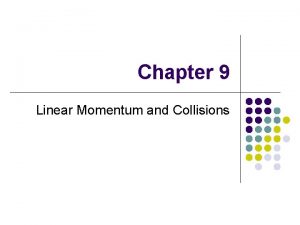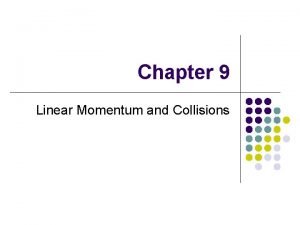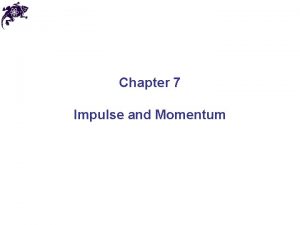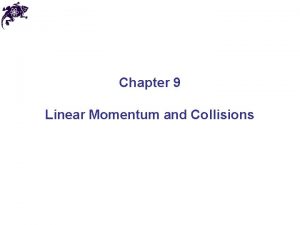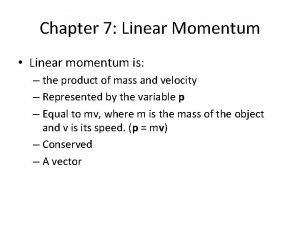Linear Momentum AP Physics C Mrs Coyle Part

























- Slides: 25

Linear Momentum AP Physics C Mrs. Coyle

Part I • Momentum • Newton’s 2 nd law expressed in terms of Momentum • Impulse • Conservation of Momentum in one Dimension

Linear Momentum, p p= mv • vector quantity • in the direction of v • unit kg m/s

Relating Force and Momentum For a particle of constant mass:

Newton’s Second Law • The time rate of change of the linear momentum of a particle is equal to the net force. • This is the form in which Newton presented the Second Law. F = dp/dt

• For a constant force: ΣF= Δp / Δt

Impulse, I = Dp (Change in Momentum) For a constant Force : Dp=m. Dv=Ft • When considering change in momentum you must consider the vector change in momentum. • If momenta are in one dimension it is enough to assign the proper sign. • If momenta are in two dimensions the momentum change must be found by subtracting the final –initial momentum vectors.

Impulse for a constant force Dp = mvf –mvi Dp= m. Dv Dp= ΣF t

Impulse • From Newton’s Second Law: F = dp/dt dp = Fdt

Change in Momentum in Two Dimensions • A tennis ball bounces as shown. Express the change in momentum in terms of m, v, q. q v Wall v Ball q

Graph • Impulse is the area under a F vs t graph. F t

Conservation on Momentum • In the absence of an external force the momentum of a system is conserved. • That means that the vector sum of the momenta before and after an impact must be equal.

Conservation of Momentum in One Dimension m 1 v 1 + m 2 v 2 = m 1 v 1 + m 2 v 2

Part II • Elastic and Inelastic Collisions • Conservation of Momentum in two Dimensions

Elastic and Inelastic Collisions • Elastic: Momentum and Kinetic Energy are both conserved. • Inelastic: Momentum is conserved but Kinetic Energy not conserved. – Perfectly Inelastic: the objects stick together during the collision.

Note • Momentum is conserved in all collisions.

Inelastic Collisions • Kinetic Energy is not conserved. • The objects are often deformed, or become attached to one another during the collision(perfectly inelastic). • Kinetic energy turns to heat, sound, etc.

Collisions in two Dimensions • For problems with collision in two dimensions, since momentum is a vector, use conservation of momentum separately in the x axis and in the y axis.

Example #34 • A proton moving with a velocity of vi I, collides elastically with another proton that is initially at rest. If the two protons have equal speeds after the collision, find: a) The speed of each proton after the collision in terms of vi b) The direction of the velocity vectors after the collision. Ans: a) v=vi / 21/2 b) 450 above +x, 450 below +x

Example #21 • A 45. 0 kg girl is standing on a 150 kg plank on a frozen lake. Initially they are both at rest. The girl then walk along the plank with a speed of 1. 50 m/s relative to the plank. Find the speed of the girl and the plank relative to the ground. Ans: vp = -0. 346 m/s, vg =1. 15 m/s

Example #25 • A 12. 0 g wad of sticky clay is hurled horizontally at a 100 g wooden block. After impact, the block slides 7. 50 m before coming to rest. If the coefficient of friction between the block and the surface is 0. 650, what was the speed of the clay immediately before impact? • Answer: 91. 2 m/s

Example #67 • A 5. 00 g bullet moving with an initial speed of 400 m/s is fired into and passes through a 1. 00 kg block. The block, initially at rest on a frictionless, horizontal surface, is connected to a spring with a force constant of 900 N/m. If the block moves 5. 00 cm to the right after the impact find: a) The speed at which the bullet emerges from the block b) The mechanical energy converted into internal energy in the collision. Ans: a) 100 m/s, b)374 J

Example: Conservation of Momentum in Two Dimensions A firecracker traveling with a velocity of 3 m/s in the direction of the +x axis, explodes and breaks up into two equal pieces. After the explosion, one piece flies off with a velocity of 2 m/s at an angle of 30 degrees above the +x axis. Find the velocity of the second piece. Ans: Vx= 4. 27 m/s Vy=-1 m/s V=4. 39 m/s 13 degr below +x-axis

Ex: Ballistic Pendulum

Ex: Ballistic Pendulum The ballistic pendulum was used to measure speeds of bullets in the old days. The large block of wood has a mass of 5. 4 kg. A bullet of mass 9. 5 g is fired into the block. The bullet is embedded into the block and the two rise to a maximum height of 6. 3 cm. What is the speed of the bullet prior to collision? Ans: 630 m/s
 Linear impulse equation
Linear impulse equation They are mrs garcia and mrs castro
They are mrs garcia and mrs castro They are mrs garcia and mrs castro
They are mrs garcia and mrs castro Mrs. darling was ___________ of mrs. s.
Mrs. darling was ___________ of mrs. s. Conceptual physics chapter 6 momentum
Conceptual physics chapter 6 momentum L coyle
L coyle Coyle method
Coyle method Coyle and castello method
Coyle and castello method Caitlin coyle
Caitlin coyle Do coyle clil
Do coyle clil Philippe goret
Philippe goret Coyle
Coyle Coyle health and wellbeing
Coyle health and wellbeing Coyle electric
Coyle electric Aaron coyle
Aaron coyle Do coyle
Do coyle Dr christine coyle
Dr christine coyle Physics 03-01 work and the work-energy theorem
Physics 03-01 work and the work-energy theorem Momentum units
Momentum units Angular impulse-angular momentum theorem
Angular impulse-angular momentum theorem Angular quantities
Angular quantities An 82 kg male and a 48 kg female
An 82 kg male and a 48 kg female Direction of torque
Direction of torque Ap physics momentum
Ap physics momentum Ap physics momentum and impulse
Ap physics momentum and impulse Conceptual momentum
Conceptual momentum





